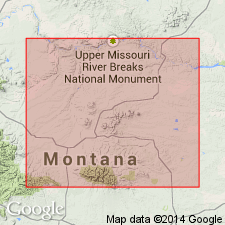
- Usage in publication:
-
- Forestgrove member
- Modifications:
-
- Named
- Dominant lithology:
-
- Limestone
- Shale
- Gypsum
- Coal
- Dolomite
- AAPG geologic province:
-
- Central Montana uplift
Summary:
Named informally "Forestgrove member" of middle part of Heath Formation. Named for Forestgrove, Fergus Co, MT, Central Montana uplift. No type locality designated. Can be correlated over a 120 sq mi area. Divided into Potter Creek coal bed (new), at base, interbedded shale and limestone unit, in middle, and "Loco Ridge gypsum bed" (new), at top. Cox Ranch oil shale bed in middle unit named. Middle unit composed of black calcareous shale and black laminated to massive limestone. Has two fossil debris zones. Limestones are black and fossiliferous. Also includes black dolomite and black mudstone. Shale is black, fossiliferous and ranges from calcareous to noncalcareous. Gypsum is brown to gray black. Lower contact placed at base of coal (Potter Creek) with gray to black mudstone of lower Heath. Upper contact placed at top of flat-pebble limestone conglomerate (Loco Ridge) with shale of upper Heath. Ranges from 43 to 65 ft thick. Of Mississippian age. Measured sections. Stratigraphic diagram. Geologic map.
Source: GNU records (USGS DDS-6; Denver GNULEX).
For more information, please contact Nancy Stamm, Geologic Names Committee Secretary.
Asterisk (*) indicates published by U.S. Geological Survey authors.
"No current usage" (†) implies that a name has been abandoned or has fallen into disuse. Former usage and, if known, replacement name given in parentheses ( ).
Slash (/) indicates name conflicts with nomenclatural guidelines (CSN, 1933; ACSN, 1961, 1970; NACSN, 1983, 2005, 2021). May be explained within brackets ([ ]).

